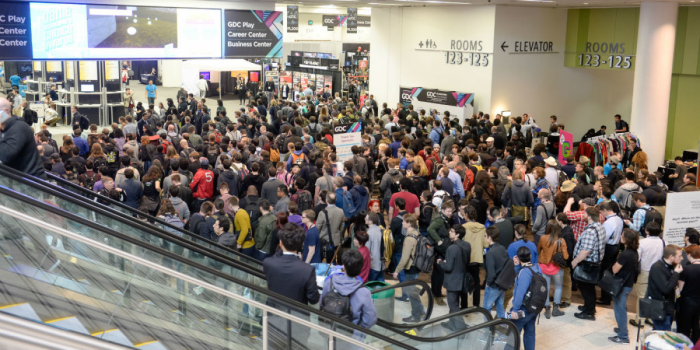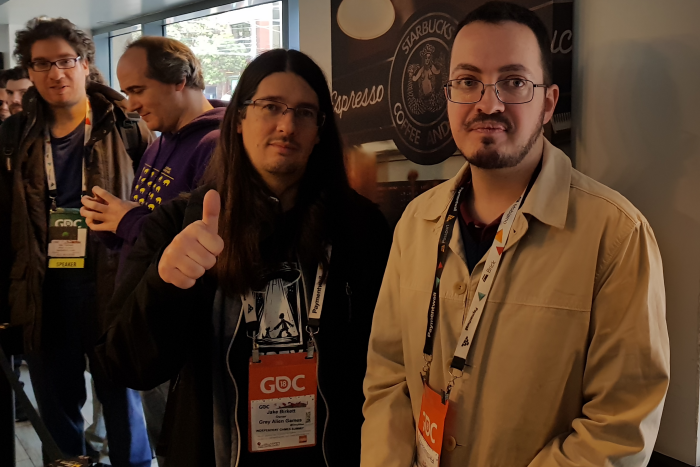So… the interwebs are awash with the happy high-fiving post-GDC backslapping and cheering and ‘omg this was what my GDC experience was like!’, so in typical cynical British fashion I thought I would put fingertips to keys for my alternative take.
Some background: I’ve been an indie dev for 20 years and coding for 38 years (not a typo). I’ve released over a dozen games, including Kudos, Gratuitous Space Battles, Democracy and production Line. I’ve also published some games. I work full time doing this as my job, and live in rural UK. I’m 49 (bloody hell!) and married.
I went a LONG time as an indie before finally giving in and going to GDC a few years ago. I remember my first experience being one of nervousness at not knowing ANYBODY, so I followed Jake Birkett of Grey Alien games, (who I’ve known for years) like a little lost and bewildered puppy hoping nobody would notice I was a total n00b to it all. The next year I went back, and the next year etc. This year was the first time I missed it since I started going.

As an alternative to GDC this year I did pop along to a way smaller London event, and spoke a bit about Unity and making your own engine, and met up with some UK indies I’ve known a long time to chat about stuff, which I’m really glad I did. Its a 2-3 hour trip from my house to London, so I stayed over in a local hotel. Drink was drunk, Lamb was eaten, jokes were made.
My decision to avoid GDC this year was very deliberate, but not a complete rejection of the whole concept. I may well return there next year, but my motivations for doing so will be almost entirely opposite to the motivations of people who attend their first GDC, so I thought it worth talking through how I feel about it. In that spirit, lets start by being negative (hey…British!) by listing what people do NOT tell you about GDC.
Negative Item #1: San Francisco. I actually got married in the US, and we stayed briefly in SF on our honeymoon. It was fab. The golden gate bridge! the trolleybusses! the huge pancakes! it was lovely. A great tourist town. Really cool. Almost 20 years later and… Oh…my…god. I’m not sure whats worse, the fact that there are *so many* homeless people or the fact that local residents have got used to totally blanking them. I’ve occasionally given cash to them, sometimes when I’m in a good mood, a fair bit of cash. One guy shouted ‘are you serious man?’ at me once. I guess they are used to being ignored, an inconvenience. an embarrassment. As a visitor, its totally shocking. And many of them seem to have untreated mental health issues.

I know all big cities have a problem with homelessness, but having just got back from London I know its TEN times worse, (at least to the casual visitor) in SF. Bad as the homelessness is, its not the only problem. There are parts of SF that you are very clearly warned DO NOT GO THERE. The really scary bit? they are maybe *one* street away from five star hotels. Its like some dystopian sci-fi future.
In a very small way, I’m not going this year to protest that San Fran will not deal with its problems. This is not a poor city. And frankly, I don’t go abroad much. I don’t want to spend half my time worrying about being stabbed, or getting depressed about homelessness. Other really nice US cities are available. Also, WTF is wrong with Las Vegas? come on guys… Vegas!
Negative item #2: Money. Luckily, the gods of market forces have been good to me (also I work like a fucking maniac and have 20 years indie experience and no kids), so my company does very well. I admit it, I fly business class when I visit the show. I can afford to buy a complete GDC show pass if I wanted to ( I do not). The cost of that pass?
$2,499

This is for a conference pass. Not a new laptop, or a new laptop + apple iphone X plus 3 course meal. Its just a pass that lets you actually go to everything at the show. They have to be absolutely kidding right? By the way, that just gets you into the show. Your food & drinks are extra, your hotel extra, your flights extra, your transfers from hotel, extra. Is this serious? and that brings me onto my next item:
Negative item#3: AFAIK hardly anyone is getting paid. The speakers? they get a free pass (OMG at $2,499 value!!!), but fuck-all else. You think they get free flights too? free hotel rooms? nope. Nothing, at least not the last time I checked. The CONTENT at the show (the talks) are provided by volunteers. At least everyone else got paid. But no, most of the ‘helpers’ at the show are volunteers too, they aren’t getting paid either.
People want to start a discussion of unionization in game dev? FFS lets start here. You give a talk at a show where the tickets are two thousand dollars, you need to get PAID for your time. I’ve spoken at GDC twice (one indie rant, one talk with 3 or 4 other devs). I’m never doing it again. My time IS money, especially if I have to spend my own money to get there and back. FWIW, other shows sometimes DO pay, and sometimes even for flights & hotels.
The thing is, you may consider all this to be worth it if the actual content of the show really improves your business right? I totally agree with you but that means item 4:
Negative item#4: The overwhelming majority of the talks are of zero use to you. This is not a dig at the speakers, many of whom are excellent and put a lot of (unpaid) work into them (including the work done by everyone who ‘submits’ a talk, but gets rejected). The fact is… game dev is a vast topic and a lot of platforms, genres and technologies are in play. The vast majority of it is NOT helpful to you. For example, are you a mobile dev using java and opengl to make an MMO? Awesome, but me giving a talk on optimising C++ and directx for PC strategy games is probably fucking useless for you.

Unless you are bizdev + marketing + finance + coder (all languages) + artist + animator + designer… the overwhelming majority of talks are not in your area. And guess what… multiple talks happen at once, so the chances are you will miss some of the ones you wanted to go to anyway. And oh… sometimes there isn’t enough room, so you will not get to attend a talk anyway.
Of course that applies to any big show, but that doesn’t mean its not a factor. Also applicable to every other big show is…
Negative item#5: You may well get ill. Or suffer in other ways. I used to laugh at people who used hand sanitizer and fistbumping. What feeble office-jockeys are they? whats the worst that can happen? Then it happened to me. I was ill after the show. very ill. Horribly ill. Embarrassingly ill. Get me drunk and ask for details one day. Its actually quite funny, but at the time: No. It was BAD. You are shaking hands with hot sweaty geeks from all over the planet. You *will* get ill at some point, and lose productivity.
Also, even if you don’t get ill, if you are a shy introvert coder like me, GDC is NOT DESIGNED FOR YOU. There are a lot of very confident, loud, assertive, extroverted, friendly, upbeat Americans who will talk extremely loudly in very loud bars absolutely packed with people who all seem to already know each other. You think you will enjoy trying to close a publishing deal over cocktails in a loud dark nightclub where people are yelling across you? You will not enjoy that. Nobody does, and yet its the same, every year.

So given all this… why the fuck did I ever go back?
The Good Stuff. GDC, like any big game show allows you to meet probably at least a hundred people who *do what you do*, and are as keen to talk about it as you are. You will hear a lot of business insider stuff. You will be exposed to lots of ideas, and get insight into the way the industry is heading. We are all still apes in T shirts, so physically meeting and sharing coffee/beer with someone means you are WAY more likely to work with them in the future. Networking is a REAL thing, and GDC is the heart of games industry networking. Despite everything I’ve typed here, you should all go to it once (if you can afford it).
And I admit, that even as I type this extended long-form rant, I do regret the fact that so many people I’ve met before at GDC, like Ron, Tommy, Brad, Chet, Ichiro, John & so many others… I’m just not going to see this year and thats kinda sad. TBH, I go there more for the meals and the drinks and the banter and jokes than any actual *biz* need, but I miss all you people, and wish we could hang out.

Oh and BTW I missed out my ‘kinda preachy’ (*but if you know me well, you will know its my primary reason*) argument for NOT going to GDC. I’m an environmentalist, and if you are too, you either need to not keep jumping on long distance airplanes that pump out serious CO2, or you need to offset the fuck out of it when you do go. I *did* consider flying & offsetting but decided against it.
Anyway… hope this isn’t too depressing. Its my honest take. Be aware of survivor bias, and peoples desire to always appear happy on social media. People are not going to tweet ‘Went to GDC, was expensive and crowded and probably a waste of time’. Nobody does that, but some people likely did think it. Of course, YMMV :D.